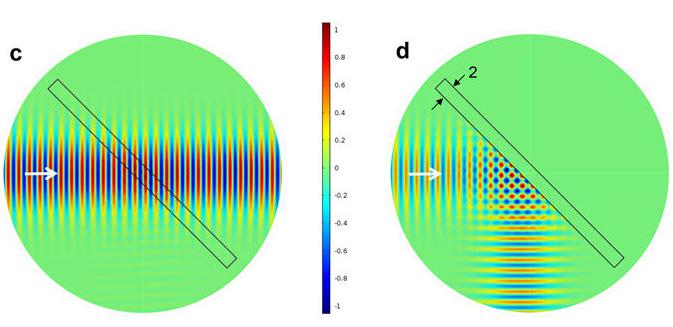Researchers create new technique for manipulating polarization of terahertz radiation

Researchers have developed a new device that can split a beam of terahertz radiation by polarization state. Credit: Mittleman Lab / Brown University
The technique uses stacks of carefully spaced metal plates to make a polarizing beamsplitter, a device that splits a beam of light by its differing polarization states, sending vertically polarized light in one direction and horizontally polarized light in another. Such a beamsplitter could be useful in a wide variety of systems that make use of terahertz radiation, from imaging systems to future communications networks.
In the imaging world, the ability to deliver and detect radiation at different polarizations could be useful in terahertz microscopy and material characterization. In communications, polarized beams can enable multiple data streams to be sent down the same medium without interference.
“This stack-of-plates idea has advantages over traditional methods of manipulating polarization in the terahertz region,” said Dan Mittleman, a professor in Brown's School of Engineering and senior author of a research paper describing the work in the journal Scientific Reports. “It's cheaper and physically more robust than other methods, and it's more versatile in what it allows us to do.”
Rajind Mendis, a research assistant professor at Brown, led the work along with Mittleman, Brown graduate student Wei Zhang and Masaya Nagai, an associate professor at Osaka University in Japan.
The terahertz range is the swath of the electromagnetic spectrum between microwave and infrared frequencies. Use of terahertz waves in technological applications such as spectroscopy, sensing, imaging and ultra-high-bandwidth communications is growing, and researchers are working to develop the hardware components necessary to build these advanced terahertz systems.
Polarization refers to the orientation of an electromagnetic wave's peaks and valleys as the wave propagates. If a wave is propagating toward you, the peaks and valleys can be oriented vertically, horizontally or anywhere in between.
“Polarization is one of the key properties of any electromagnetic wave,” Mittleman said. “Being able to manipulate polarization — to measure it or to change it — is one of the important capabilities you need in any electromagnetic system.”
In the visible light realm, for example, manipulating polarization is used to create modern 3-D movies and to make sunglasses that reduce the glare of reflected light. Polarizing sunglasses are made by arranging polymer strands horizontally within lenses like bars on a jail cell. Those strands allow light that's polarized vertically to pass through, while blocking horizontally polarized light, which is the dominant polarization state of light reflected off shiny surfaces like cars and water.
Existing methods of manipulating polarization in the terahertz range are very similar to the technique used in polarizing sunglasses, albeit scaled to the much longer wavelengths of terahertz light compared to visible light. Polarizing filters for terahertz are generally an array of metal wires a few microns in diameter and spaced several microns apart.
The new technique the Brown and Osaka team developed replaces the wires with a stack of closely-spaced steel plates. Each pair of plates forms what's known as a parallel-plate waveguide. When terahertz light is shined on the stack at a 45-degree angle, it splits the beam by exciting two waveguide modes. One beam of vertically polarized light passes straight through the device, while another beam of horizontally polarized light is reflected in a 90-degree angle from the original beam axis.
The technique has a number of advantages over traditional wire filters, the researchers say. The stack-of-plates architecture, which is knows as an “artificial dielectric,” is easy to make, and the materials are inexpensive. The plates are also much less fragile than wires.
“The artificial-dielectric concept also makes the device more versatile,” Mendis said. “The device can be easily tuned for use at different terahertz frequencies simply by changing the size of the spacers separating the plates or by changing the illuminating angle.”
Another advantage is that with the addition of a second similar artificial-dielectric structure, the researchers were able to build a device called an isolator. Isolators are used on high-powered lasers to prevent light from being reflected back into a laser emitter, which could destabilize or even damage it. A terahertz isolator could be an important component for future high-powered terahertz devices.
The Brown and Osaka team is in the process of patenting the new artificial-dielectric devices, and the researchers are hopeful that these devices will enable the development of new terahertz systems with far better capabilities.
“In anything you might want to do with an optical system, it's useful to be able to manipulate polarization,” Mittleman said. “This is a simple, efficient, effective and versatile way to do that.”
###
The work was supported in part by the National Science Foundation (EPMD #1609521).
Media Contact
All latest news from the category: Information Technology
Here you can find a summary of innovations in the fields of information and data processing and up-to-date developments on IT equipment and hardware.
This area covers topics such as IT services, IT architectures, IT management and telecommunications.
Newest articles

First-of-its-kind study uses remote sensing to monitor plastic debris in rivers and lakes
Remote sensing creates a cost-effective solution to monitoring plastic pollution. A first-of-its-kind study from researchers at the University of Minnesota Twin Cities shows how remote sensing can help monitor and…

Laser-based artificial neuron mimics nerve cell functions at lightning speed
With a processing speed a billion times faster than nature, chip-based laser neuron could help advance AI tasks such as pattern recognition and sequence prediction. Researchers have developed a laser-based…

Optimising the processing of plastic waste
Just one look in the yellow bin reveals a colourful jumble of different types of plastic. However, the purer and more uniform plastic waste is, the easier it is to…



